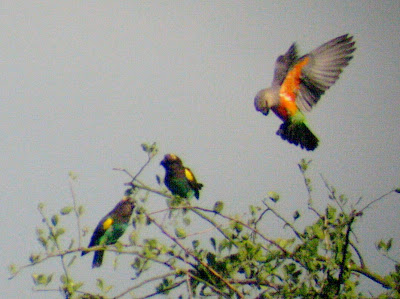Rwanda on the Wing
A blog about my experience with birds, ecology, and sustainability in Rwanda
Tuesday, July 23, 2013
Discover the Birds of Agahozo-Shalom Youth Village
Click the poster image above or this link Birds of Agahozo-Shalom Youth Village to see photographs of more than 100 species of birds that live or visit Agahozo-Shalom Youth Village. The poster, with birds drawn by an Agahozo-Shalom student, is featured at several locations at Agahozo-Shalom Youth Village in Rwanda.
Sunday, December 4, 2011
Earth on the Wing
 |
| Meyer's (brown) parrots (Poicephalus meyeri) on the left with a male African orange-bellied parrot (Poicephalus rufiventris) on the right, Tarangire National Park, Tanzania |
 |
| Yellow-billed storks (Mycteria ibis) on the wing, Ngorongoro Conservation Area, Tanzania |
 |
| White-crested helmet-shrike (Prionops plumatus), near Kibungo, Rwanda |
 |
| Denham's bustards (Neotis denhami), Murchison Falls National Park, Uganda |
 |
| African paradise flycatcher (Terpsiphone viridis), Ngorongoro Conservation Area, Tanzania |
 |
| My final photograph in Africa. Although I am no longer in Rwanda, you can read about my continuing experience with birds, ecology, and sustainability at Earth on the Wing. |
Saturday, December 3, 2011
The crane they call Umusambi
Thursday, December 1, 2011
A Rubona Sector Almanac
“There are some can live without wild things, and some who cannot. These essays are the delights and dilemmas of one who cannot.” Aldo Leopold, in the forward to A Sand County Almanac
Aldo Leopold used basic interactions between plants, animals, soils, water, and weather on his farm in Wisconsin to illustrate the complex web of ecology in A Sand County Almanac. In homage to his most famous writing and my favorite book, I compiled a few brief observations over the past year from each month to celebrate a small piece of land in the Rwandan countryside.
Leopold started with the awakening of a slumbering skunk in the first mid-winter-thaw in January and finished the month-by-month progression with the birds struggling to grapple with the colds of December. In Rwanda, which has a small temperature range all year round, the seasons are less clear. There is a distinctive dry season (June-August) and a distinctive wet season (September-November), but the rest of the time, it is just less wet and less dry. For those of you interested in the wild things in your backyard, this is a snapshot of a few wild things in my backyard this past year, a rural hillside in Rwanda.
December
You wake up in a fog. There are hills flowing over the earth’s crust in every direction but you might as well be anywhere. The birds are timid in the fog and you can get closer to them than usual, if only you could see them clearly. Unless rains come, the sun will bake off the fog within an hour. It feels hot by 8 AM, but the equatorial sun is mitigated by our elevation of 1,550 meters (about 1 mile).
Monday, November 28, 2011
Visiting the relatives
We share around 98% of our genes with chimpanzees, according to the San Diego Zoo. In Kibale National Park, Uganda, these relatives rule the forest.
Saturday, November 12, 2011
Leave only footprints
 |
| Hippo prints, Murchison Falls National Park, Uganda. Note the tire track on the right came before the hippo passed. |
Tracks from the past
Impressions in the mud
Here but now gone
Our footprints linger on
 |
| Leopard print, Ngorongoro Conservation Area, Tanzania |
Take only memories
Leave only shapes
Elephants, hippos,
Leopards and apes
Friday, November 11, 2011
Art and science collide!
Binoculars. Colored pencils. Early mornings. Rough drafts. In a world full of birds, art and science combine to make bird knowledge accessible.
Agahozo-Shalom is rich in birds, and now its students can learn about them with a new poster illustrating more than 30 of the most common species.
 |
| Red-eyed dove - Streptopelia semitorquata - Inumah |
Agahozo-Shalom is rich in birds, and now its students can learn about them with a new poster illustrating more than 30 of the most common species.
 |
| Meet the artist: Rossi, a 9th grade student at ASYV, drew most the birds. He was president of the student art club and spent his free time on Saturdays and Sundays illustrating our feathered friends. |
Subscribe to:
Comments (Atom)






